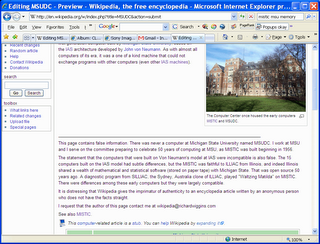 Click to see full-size screen shot
Click to see full-size screen shotMISTIC was based on a design by the legendary John Von Neumann at Princeton, a design offered to the world and replicated 15 times. Wikipedia reports that MSU also built a computer called MSUDC. There is no evidence that MSU built such a critter. It's likely that someone somewhere ran across an alternate name, never adopted, for Michigan State University Digital Computer. (MISTIC was Michigan State Integral Computer.)
Wanting to contact the author of this false information, I found links to a sort of Wikipedia screen name, and no evidence for a human's real name. So for my first venture into this world, I signed up to edit a Wikipedia article. The article claims:
MSUDC
From Wikipedia, the free encyclopedia
The Computer Center once housed the early computers MISTIC and MSUDC.
The MSUDC or Michigan State University Discrete Computer, was a first-generation computer built by Michigan State Universitybased on the IAS architecture developed by John von Neumann. As with almost all computers of its era, it was a one of a kind machine that could not exchange programs with other computers (even other IAS machines)
This stuff simply isn't true.
There never was a thing called the "Discrete Computer" at MSU. Some people may have called MISTIC some such thing, but MSU built one IAS computer in the late 50s, not two.
It is also most manifestly false that programs could not be exchanged among the IAS computers. Trust me, in June I interviewed the man who led the development of MISTIC, Dr. Lawrence W. Von Tersch, and he emphasized how important it was that the University of Illinois had shared mathematical and statistical software that they'd developed, which helped jump-start scientific computing at Michigan State.
And one of the IAS computers was built in Australia -- Sydney's SILLIAC, like MSU's MISTIC, a close clone of ILLIAC. They developed a diagnostic program that played out "Waltzing Matilda" -- these machines had speakers to chirp out the sounds for diagnostic purposes -- and that program was used every day at 8:00 a.m. circa 1959 to test MISTIC.
Even the statement that these computers were based on the IAS architecture is false. They were based on the IAS design. Von Neumann is famous for the stored program concept -- that a computer would have program code and data in a single shared memory. But the design that IAS offerred the world was a very specific design for a computer. You know, schematics. Each implementation had its quirks, but from what I've gleaned, ILLIAC, MISTIC, and SILLIAC were all quite close to one another in actual function.
So we have some random author of an article in an encyclopedia asserting the existence of a computer that never existed, and asserting that the 15 or so Princeton IAS Von Neumann computers couldn't run each others' programs. Both claims totally false.

In other words, virtually the entire substance of this Wikipedia entry is simply wrong.
This is my concern about Wikipedia: not that they will get "why is the sky blue?" stuff wrong, because a million people will correct that. Instead, they will get small, but important pieces of history wrong, because some well-meaning writer with poor research skills will get an important niche story wrong.
Why can't I find the real name and contact info (real phone number, primary e-mail address) for the person who wrote this article?
Here is my call to the author of the article filled with false information:
It is distressing that Wikipedia gives the imprimatur of authenticity to an
encyclopedia article written by an anonymous person who does not have the facts
straight.
I request that the author of this page contact me at
wikipedia@richardwiggins.com
For stories like this, Wikipedia puts the kid struggling to write a paper for school on the same level as a tyro who wrote a piece about an obscure piece of history. For some people I suppose that's very cool. To me it's scary.